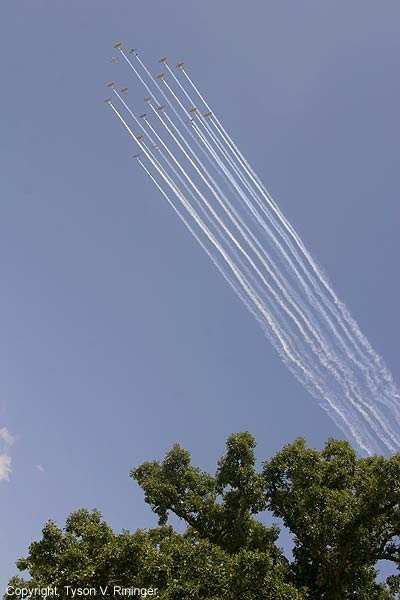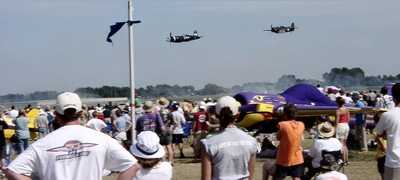EAA Submits Comments to FAA Draft Order 8700.1, Chapter 49
 The EAA says it has submitted a
number of comments on the FAA's proposed revisions to air show
regulations (FAA Draft Order 8700.1, Chapter 49). The sport plane
organization, host to one of the nation's largest aviation events
(EAA AirVenture Oshkosh), supports some measures that address
proven safety issues, such as Joint FAA/air boss safety briefings
and joint U.S. Air Force/GA industry pilots conducting the Heritage
Flight Program, showcasing military aircraft history. The
organization is very reluctant, however, to support more
restrictive operating rules that don't appear to be justified from
a safety standpoint.
The EAA says it has submitted a
number of comments on the FAA's proposed revisions to air show
regulations (FAA Draft Order 8700.1, Chapter 49). The sport plane
organization, host to one of the nation's largest aviation events
(EAA AirVenture Oshkosh), supports some measures that address
proven safety issues, such as Joint FAA/air boss safety briefings
and joint U.S. Air Force/GA industry pilots conducting the Heritage
Flight Program, showcasing military aircraft history. The
organization is very reluctant, however, to support more
restrictive operating rules that don't appear to be justified from
a safety standpoint.
"What might seem to be minor changes could have substantial
negative operational and financial implications on air show
operations without a corresponding increase in safety," said Earl
Lawrence, EAA's vice president of industry and regulatory affairs.
"That could reduce the ability of the public to experience historic
aircraft operations, increase event costs, and reduce revenues
without a corresponding documented increase in safety."

For example, a proposed rule mandates that flight directions
during air shows "shall be in one direction only." Literal
interpretation would affect just about every large warbird air show
in the country, including Oshkosh.
"Large warbird air shows feature different types of aircraft
formations flying over the crowd from many different directions,"
Lawrence explains. "Formation flights are flown at different
stacked altitudes and are always above 1000 feet AGL." As the FAA's
intent was only to place this requirement on aircraft that are
operating below 1000 feet, EAA asked FAA to delete the paragraph in
its entirety so as to eliminate confusion.
In another proposed change, FAA designates credentialed
photographers as "non-essential personnel" thereby relegating them
to shoot only from outside an air show's aerobatic box. This will
prevent any EAA or credentialed media photographers forward of the
crowd line during the daily Oshkosh air shows. Over the years, EAA
has developed and refined a strict procedure that allows a limited
number of credentialed media photographers to work within
well-defined areas in the box perimeter. As a result, there has
never been a single injury or fatality.
In lieu of safety data, EAA asks that the FAA meet with the
industry to address specific concerns outlined and not just
implement an outright ban. The comments came as a follow-up
to a AirVenture 2005 meeting with top FAA officials at EAA
headquarters in Oshkosh. Those officials included FAA's
national air show coordinator, Jeff Weller.
EAA also objects to the need to apply for a temporary flight
restriction (TFR) when non-military parachute teams perform, such
as the Liberty Parachute Team that has been a fixture of EAA
AirVenture Oshkosh air shows for the past 21 years. "The event is
already taking place in waivered airspace. There is no additional
safety to requiring the establishment of a TFR," Lawrence said.

Another proposed change EAA objects to would require the FAA's
IIC (Inspector in Charge) to approve any changes to the submitted
performer list. EAA contends that the FAA IIC should be notified of
any additions to the waiver, but they are not responsible for
approving the performers and asks FAA to revise the affected
sections to change the word "approve" to "notify." If the agency
actually intends to approve performers, then EAA asks the agency to
review the resources vs. safety benefit before attempting to
implement any such requirement.
EAA also submitted comments regarding FAA's establishment of
show lines and emergency helicopter operations, as well as FAA's
proposed strict identification of ingress/egress routes rather than
EAA's current use of no-fly zones.
 ANN's Daily Aero-Term (04.24.24): Runway Lead-in Light System
ANN's Daily Aero-Term (04.24.24): Runway Lead-in Light System ANN's Daily Aero-Linx (04.24.24)
ANN's Daily Aero-Linx (04.24.24) Aero-FAQ: Dave Juwel's Aviation Marketing Stories -- ITBOA BNITBOB
Aero-FAQ: Dave Juwel's Aviation Marketing Stories -- ITBOA BNITBOB Classic Aero-TV: Best Seat in The House -- 'Inside' The AeroShell Aerobatic Team
Classic Aero-TV: Best Seat in The House -- 'Inside' The AeroShell Aerobatic Team Airborne Affordable Flyers 04.18.24: CarbonCub UL, Fisher, Affordable Flyer Expo
Airborne Affordable Flyers 04.18.24: CarbonCub UL, Fisher, Affordable Flyer Expo





